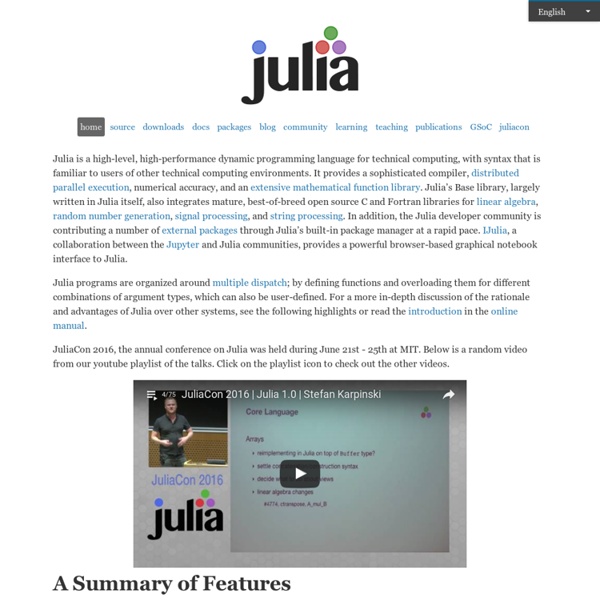Learn to Hack
Attack servers, crack passwords, exploit services, beat encryption - everything you need to protect yourself from evil. There are two rules of computer security: one – don’t buy a computer; and two – if you have to buy a computer, don’t turn it on. If you break these rules then you’ll be opening yourself up to potential problems. No system is 100% safe from hackers, but by following a few simple steps you can make yours much harder for intruders to attack.
Julia Studio
Beginner These tutorials will help you to familiarize yourself with the Julia Studio environment and the basics of the language. Hello, World!
Six Degrees of Kevin Bacon Using Neo4j and Ruby
Previously I showed you how to get Neo4j up and running with Ruby and how to find recommended friends on a social network. What about finding out how you are connected to someone outside of your friends of friends network? Do you remember the concept of six degrees of separation?
Code Week EU 2016 – Skill up for the digital world with #codeEU!
EU Code Week is a grass-root movement run by volunteers who promote coding in their countries as Code Week Ambassadors. Last year more than half a million people participated in nearly 8,000 coding events in 46 countries in Europe and beyond. This year Code Week is teaming up with Public Libraries 2020, a network of 65.000 local libraries in the EU. They aim to organise "coding corners" or coding workshops in local libraries around Europe. As in 2015, schools are invited to organise coding events under the CodeWeek4All challenge involving as many students and pupils as possible. Schools who reach at least a 50% participation rate will receive a Certificate of Excellence in Coding Literacy.
In-depth introduction to machine learning in 15 hours of expert videos
In January 2014, Stanford University professors Trevor Hastie and Rob Tibshirani (authors of the legendary Elements of Statistical Learning textbook) taught an online course based on their newest textbook, An Introduction to Statistical Learning with Applications in R (ISLR). I found it to be an excellent course in statistical learning (also known as “machine learning”), largely due to the high quality of both the textbook and the video lectures. And as an R user, it was extremely helpful that they included R code to demonstrate most of the techniques described in the book.
PHP: a fractal of bad design - fuzzy notepad
(This article has been translated into Spanish (PDF, with some additions) by Jorge Amado Soria Ramirez — thanks!) Preface I’m cranky. I complain about a lot of things.
What is R?
During the last decade, the momentum coming from both academia and industry has lifted the R programming language to become the single most important tool for computational statistics, visualization and data science. Worldwide, millions of statisticians and data scientists use R to solve their most challenging problems in fields ranging from computational biology to quantitative marketing. R has become the most popular language for data science and an essential tool for Finance and analytics-driven companies such as Google, Facebook, and LinkedIn. Watch this 90 second video for an introduction to R This video is free to download, remix and share! Every data analysis technique at your fingertips
Fancy FAQ page using CSS3 only
Usually, a FAQ page is that long page with lots of questions and answers, the one we are searching for when we need some extra info regarding a subject. So, for example, if you own a website that sells stuff, then you will need a page like that. In this article I'll show you how to create a fancy FAQ page using CSS3 only, no JavaScript. View demo
18 Free Tutorials for Learning R Programming
R is a powerful tool for data scientists and statisticians. The capabilities of R are being further developed daily by the proactive user base at the Comprehensive R Archive Network. The applications of R are becoming greater as the number of add-on packages increases. Learning the basics of R now will unlock the door to a very useful tool for presenting and analyzing data. Here are some free resources for learning R programing. Quick R – Quick R is a great reference site for learning all the fundamentals of R.
Interpreted Languages: PHP, Perl, Python, Ruby (Sheet One) - Hyperpolyglot
a side-by-side reference sheet sheet one: version | grammar and execution | variables and expressions | arithmetic and logic | strings | regexes | dates and time | arrays | dictionaries | functions | execution control | exceptions | threads sheet two: streams | asynchronous events | files | file formats | directories | processes and environment | option parsing | libraries and namespaces | objects | inheritance and polymorphism | reflection | net and web | gui | databases | unit tests | logging | debugging
Federal Reserve Economic Data
Skip to main content Economic Research Federal Reserve Bank of St. Louis My Account Register Sign in
Using HTML5 to Create Charts and Graphs
Today I found an interesting library – flotr2: an opensource library for drawing HTML5 charts and graphs. It allows you to draw charts in different formats such as: linesbarscandlespiesbubbles
Best Programming / Developer Laptops List
What is it? The CPU (Central Processing Unit), also called a processor, is the glorified calculator that is the very brains of your machine. It runs all calculations and is responsible for carrying out instructions and operations to and from the rest of the machine. How much do I need? If you aren’t capping out the capabilities of your processor, then you are wasting it. An Intel Core i7-4700HQ is a quad-core processor that is really quite powerful, and it’s a great option for a lot of people who are into high end gaming or need to run simulations or do CAD work.



